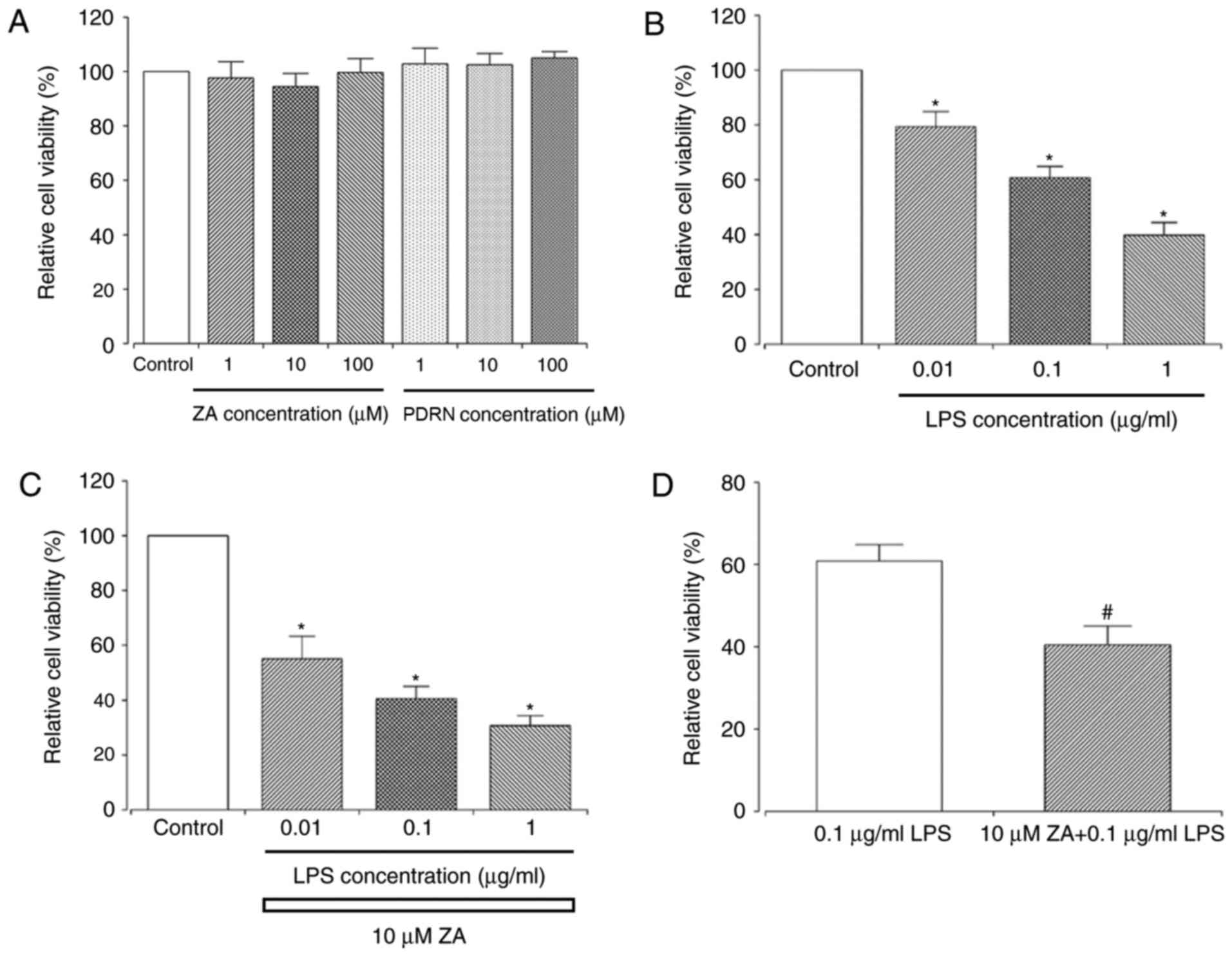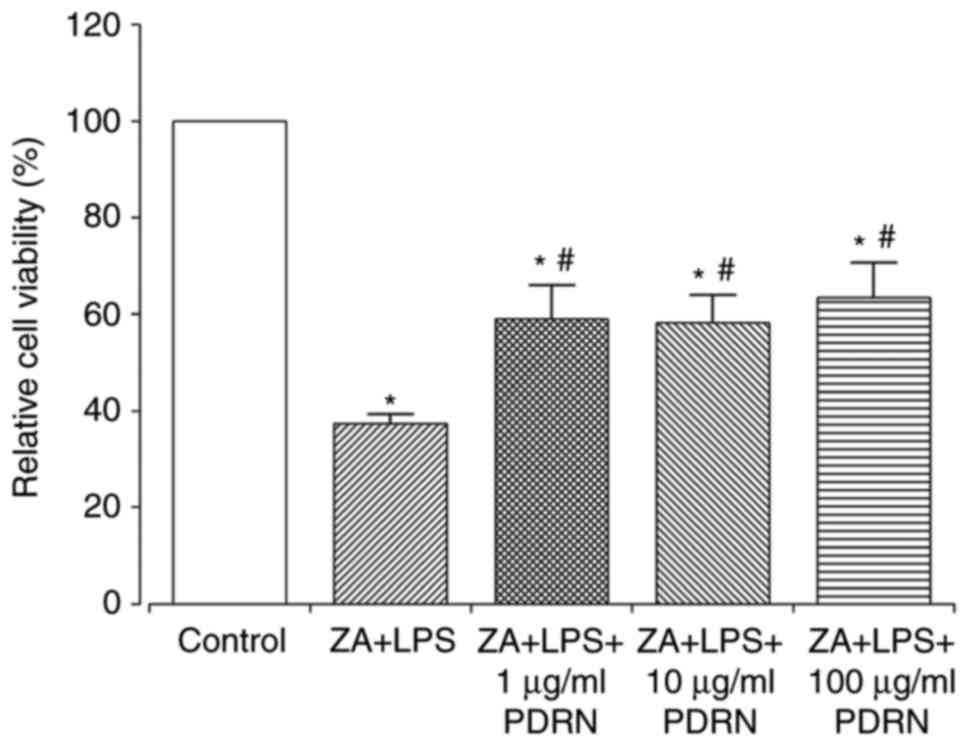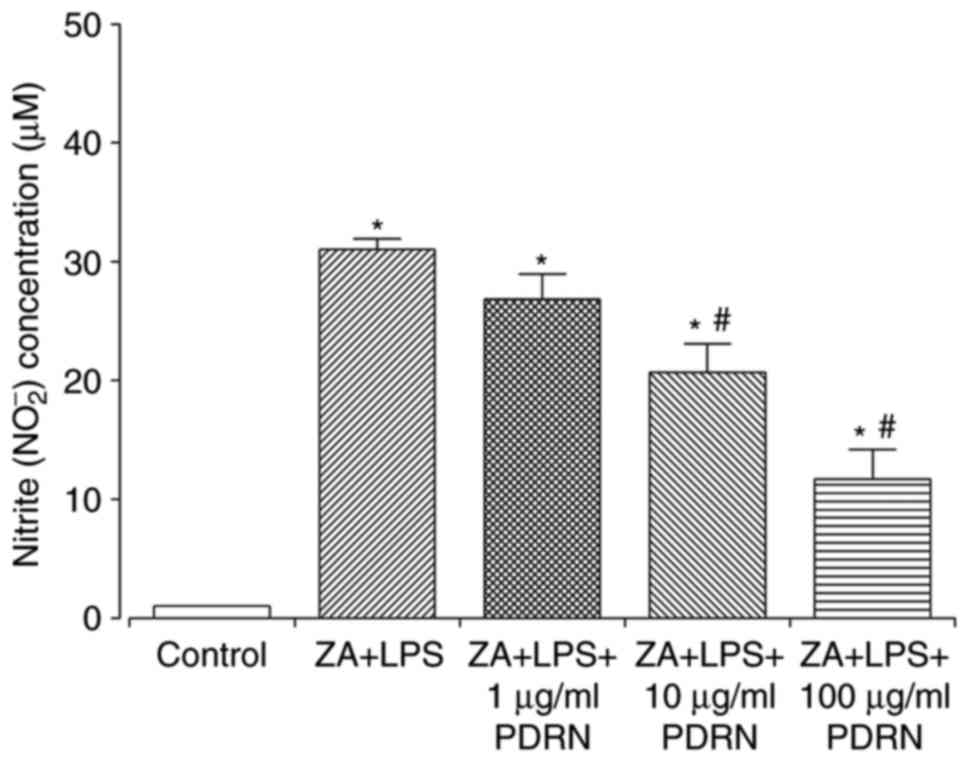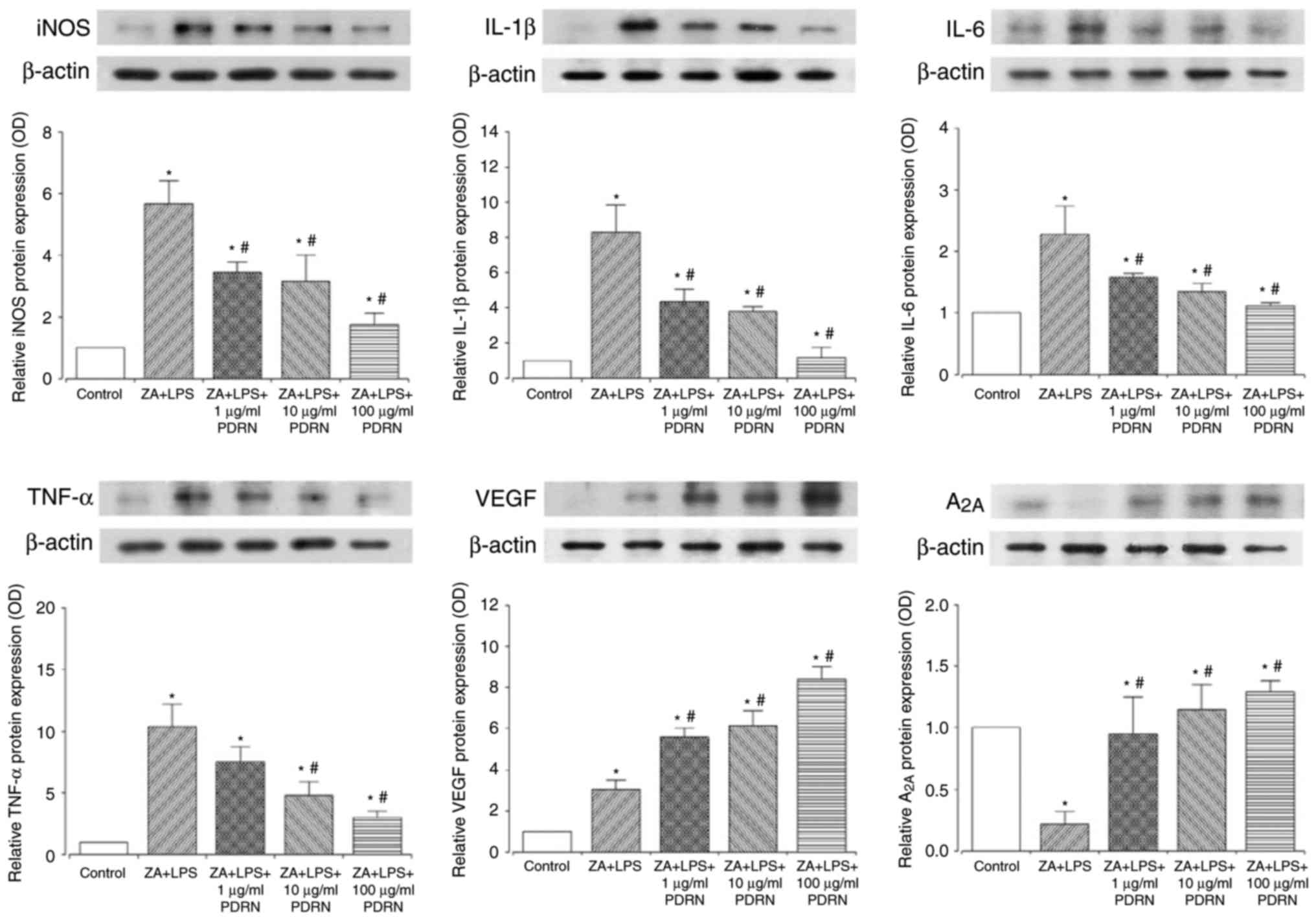|
1
|
Pennanen N, Lapinjoki S, Urtti A and
Mönkkönen J: Effect of liposomal and free bisphosphonates on the
IL-1 beta, IL-6 and TNF alpha secretion from RAW 264 cells in
vitro. Pharm Res. 12:916–922. 1995. View Article : Google Scholar : PubMed/NCBI
|
|
2
|
Berenson JR and Lipton A: Bisphosphonates
in the treatment of malignant bone disease. Annu Rev Med.
50:237–248. 1999. View Article : Google Scholar : PubMed/NCBI
|
|
3
|
Lipton A: Emerging role of bisphosphonates
in the clinic-antitumor activity and prevention of metastasis to
bone. Cancer Treat Rev. 34 Suppl 1:S25–S30. 2008. View Article : Google Scholar : PubMed/NCBI
|
|
4
|
van Beek ER, Cohen LH, Leroy IM, Ebetino
FH, Löwik CW and Papapoulos SE: Differentiating the mechanisms of
antiresorptive action of nitrogen containing bisphosphonates. Bone.
33:805–811. 2003. View Article : Google Scholar : PubMed/NCBI
|
|
5
|
Pataki A, Muller K, Green JR, Ma YF, Li QN
and Jee WS: Effects of short-term treatment with the
bisphosphonates zoledronate and pamidronate on rat bone: A
comparative histomorphometric study on the cancellous bone formed
before, during, and after treatment. Anat Rec. 249:458–468. 1997.
View Article : Google Scholar : PubMed/NCBI
|
|
6
|
Rogers MJ: New insights into the molecular
mechanisms of action of bisphosphonates. Curr Pharm Des.
9:2643–2658. 2003. View Article : Google Scholar : PubMed/NCBI
|
|
7
|
Marx RE: Pamidronate (Aredia) and
zoledronate (Zometa) induced avascular necrosis of the jaws: A
growing epidemic. J Oral Maxillofac Surg. 61:1115–1117. 2003.
View Article : Google Scholar : PubMed/NCBI
|
|
8
|
Ruggiero SL, Dodson TB, Fantasia J,
Goodday R, Aghaloo T, Mehrotra B and O'Ryan F: American Association
of Oral and Maxillofacial Surgeons: American Association of oral
and maxillofacial surgeons position paper on medication-related
osteonecrosis of the jaw-2014 update. J Oral Maxillofac Surg.
72:1938–1956. 2014. View Article : Google Scholar : PubMed/NCBI
|
|
9
|
Spinelli G, Torresetti M, Lazzeri D, Zhang
YX, Arcuri F, Agostini T and Grassetti L: Microsurgical
reconstruction after bisphosphonate-related osteonecrosis of the
jaw: Our experience with fibula free flap. J Craniofac Surg.
25:788–792. 2014. View Article : Google Scholar : PubMed/NCBI
|
|
10
|
Tsurushima H, Kokuryo S, Sakaguchi O,
Tanaka J and Tominaga K: Bacterial promotion of
bisphosphonate-induced osteonecrosis in Wistar rats. Int J Oral
Maxillofac Surg. 42:1481–1487. 2013. View Article : Google Scholar : PubMed/NCBI
|
|
11
|
Hoff AO, Toth BB, Altundag K, Johnson MM,
Warneke CL, Hu M, Nooka A, Sayegh G, Guarneri V, Desrouleaux K, et
al: Frequency and risk factors associated with osteonecrosis of the
jaw in cancer patients treated with intravenous bisphosphonates. J
Bone Miner Res. 23:826–836. 2008. View Article : Google Scholar : PubMed/NCBI
|
|
12
|
Xie C, Kang J, Li Z, Schauss AG, Badger
TM, Nagarajan S, Wu T and Wu X: The açaí flavonoid velutin is a
potent anti-inflammatory agent: Blockade of LPS-mediated TNF-α and
IL-6 production through inhibiting NF-κB activation and MAPK
pathway. J Nutr Biochem. 23:1184–1191. 2012. View Article : Google Scholar : PubMed/NCBI
|
|
13
|
Nicholas C, Batra S, Vargo MA, Voss OH,
Gavrilin MA, Wewers MD, Guttridge DC, Grotewold E and Doseff AI:
Apigenin blocks lipopolysaccharide-induced lethality in vivo and
proinflammatory cytokines expression by inactivating NF-kappaB
through the suppression of p65 phosphorylation. J Immunol.
179:7121–7127. 2007. View Article : Google Scholar : PubMed/NCBI
|
|
14
|
Taira J, Nanbu H and Ueda K: Nitric
oxide-scavenging compounds in Agrimonia pilosa Ledeb on LPS-induced
RAW264.7 macrophages. Food Chem. 115:1221–1227. 2009. View Article : Google Scholar
|
|
15
|
Muratsu D, Yoshiga D, Taketomi T, Onimura
T, Seki Y, Matsumoto A and Nakamura S: Zoledronic acid enhances
lipopolysaccharide-stimulated proinflammatory reactions through
controlled expression of SOCS1 in macrophages. PLoS One.
8:e679062013. View Article : Google Scholar : PubMed/NCBI
|
|
16
|
Altavilla D, Bitto A, Polito F, Marini H,
Minutoli L, Di Stefano V, Irrera N, Cattarini G and Squadrito F:
Polydeoxyribonucleotide (PDRN): A safe approach to induce
therapeutic angiogenesis in peripheral artery occlusive disease and
in diabetic foot ulcers. Cardiovasc Hematol Agents Med Chem.
7:313–321. 2009. View Article : Google Scholar : PubMed/NCBI
|
|
17
|
Squadrito F, Bitto A, Altavilla D,
Arcoraci V, De Caridi G, De Feo ME, Corrao S, Pallio G, Sterrantino
C, Minutoli L, et al: The effect of PDRN, an adenosine receptor A2A
agonist, on the healing of chronic diabetic foot ulcers: Results of
a clinical trial. J Clin Endocrinol Metab. 99:E746–E753. 2014.
View Article : Google Scholar : PubMed/NCBI
|
|
18
|
Gomez G and Sitkovsky MV: Targeting G
protein-coupled A2a adenosine receptors to engineer inflammation in
vivo. Int J Biochem Cell Biol. 35:410–414. 2003. View Article : Google Scholar : PubMed/NCBI
|
|
19
|
Cronstein BN: Adenosine, an endogenous
anti-inflammatory agent. J Appl Physiol (1985). 76:5–13. 1994.
View Article : Google Scholar : PubMed/NCBI
|
|
20
|
Bitto A, Polito F, Irrera N, D'Ascola A,
Avenoso A, Nastasi G, Campo GM, Micali A, Bagnato G, Minutoli L, et
al: Polydeoxyribonucleotide reduces cytokine production and the
severity of collagen-induced arthritis by stimulation of adenosine
A(2A) receptor. Arthritis Rheum. 63:3364–3371. 2011. View Article : Google Scholar : PubMed/NCBI
|
|
21
|
Jeong EK, Jang HJ, Kim SS, Lee SY, Oh MY,
Kim HJ, Eom DW, Ham JY and Han DJ: Protective effect of
polydeoxyribonucleotide against renal ischemia-reperfusion injury
in mice. Transplant Proc. 48:1251–1257. 2016. View Article : Google Scholar : PubMed/NCBI
|
|
22
|
Ramanathan M, Pinhal-Enfield G, Hao I and
Leibovich SJ: Synergistic up-regulation of vascular endothelial
growth factor (VEGF) expression in macrophages by adenosine A2A
receptor agonists and endotoxin involves transcriptional regulation
via the hypoxia response element in the VEGF promoter. Mol Biol
Cell. 18:14–23. 2007. View Article : Google Scholar : PubMed/NCBI
|
|
23
|
Ferrara N, Gerber HP and LeCouter J: The
biology of VEGF and its receptors. Nat Med. 9:669–676. 2003.
View Article : Google Scholar : PubMed/NCBI
|
|
24
|
Ziebart T, Pabst A, Klein MO, Kämmerer P,
Gauss L, Brüllmann D, Al-Nawas B and Walter C: Bisphosphonates:
Restrictions for vasculogenesis and angiogenesis: Inhibition of
cell function of endothelial progenitor cells and mature
endothelial cells in vitro. Clin Oral Investig. 15:105–111. 2011.
View Article : Google Scholar : PubMed/NCBI
|
|
25
|
Naik NH and Russo TA:
Bisphosphonate-related osteonecrosis of the jaw: The role of
actinomyces. Clin Infect Dis. 49:1729–1732. 2009. View Article : Google Scholar : PubMed/NCBI
|
|
26
|
Ikeda T, Kuraguchi J, Kogashiwa Y, Yokoi
H, Satomi T and Kohno N: Successful treatment of
bisphosphonate-related osteonecrosis of the jaw (BRONJ) patients
with sitafloxacin: New strategies for the treatment of BRONJ. Bone.
73:217–222. 2015. View Article : Google Scholar : PubMed/NCBI
|
|
27
|
Boff RC, Salum FG, Figueiredo MA and
Cherubini K: Important aspects regarding the role of microorganisms
in bisphosphonate-related osteonecrosis of the jaws. Arch Oral
Biol. 59:790–799. 2014. View Article : Google Scholar : PubMed/NCBI
|
|
28
|
Sakaguchi O, Kokuryo S, Tsurushima H,
Tanaka J, Habu M, Uehara M, Nishihara T and Tominaga K:
Lipopolysaccharide aggravates bisphosphonate-induced osteonecrosis
in rats. Int J Oral Maxillofac Surg. 44:528–534. 2015. View Article : Google Scholar : PubMed/NCBI
|
|
29
|
Burney S, Caulfield JL, Niles JC, Wishnok
JS and Tannenbaum SR: The chemistry of DNA damage from nitric oxide
and peroxynitrite. Mutat Res. 424:37–49. 1999. View Article : Google Scholar : PubMed/NCBI
|
|
30
|
Makkonen N, Hirvonen MR, Teräväinen T,
Savolainen K and Mönkkönen J: Different effects of three
bisphosphonates on nitric oxide production by RAW 264
macrophage-like cells in vitro. J Pharmacol Exp Ther.
277:1097–1102. 1996.PubMed/NCBI
|
|
31
|
Kobayashi Y: The regulatory role of nitric
oxide in proinflammatory cytokine expression during the induction
and resolution of inflammation. J Leukoc Biol. 88:1157–1162. 2010.
View Article : Google Scholar : PubMed/NCBI
|
|
32
|
Adami S, Bhalla AK, Dorizzi R, Montesanti
F, Rosini S, Salvagno G and Lo Cascio V: The acute-phase response
after bisphosphonate administration. Calcif Tissue Int. 41:326–331.
1987. View Article : Google Scholar : PubMed/NCBI
|
|
33
|
Koide N, Odkhuu E, Naiki Y, Tsolmongyn B,
Ito K, Komatsu T, Yoshida T and Yokochi T: Augmentation of
LPS-induced vascular endothelial cell growth factor production in
macrophages by transforming growth factor-β1. Innate Immun.
20:816–825. 2014. View Article : Google Scholar : PubMed/NCBI
|
|
34
|
Ben-Av P, Crofford LJ, Wilder RL and Hla
T: Induction of vascular endothelial growth factor expression in
synovial fibroblasts by prostaglandin E and interleukin-1: A
potential mechanism for inflammatory angiogenesis. FEBS Lett.
372:83–87. 1995. View Article : Google Scholar : PubMed/NCBI
|
|
35
|
De Ponti C, Carini R, Alchera E, Nitti MP,
Locati M, Albano E, Cairo G and Tacchini L: Adenosine A2a
receptor-mediated, normoxic induction of HIF-1 through PKC and
PI-3K-dependent pathways in macrophages. J Leukoc Biol. 82:392–402.
2007. View Article : Google Scholar : PubMed/NCBI
|
|
36
|
Polito F, Bitto A, Galeano M, Irrera N,
Marini H, Calò M, Squadrito F and Altavilla D:
Polydeoxyribonucleotide restores blood flow in an experimental
model of ischemic skin flaps. J Vasc Surg. 55:479–488. 2012.
View Article : Google Scholar : PubMed/NCBI
|













